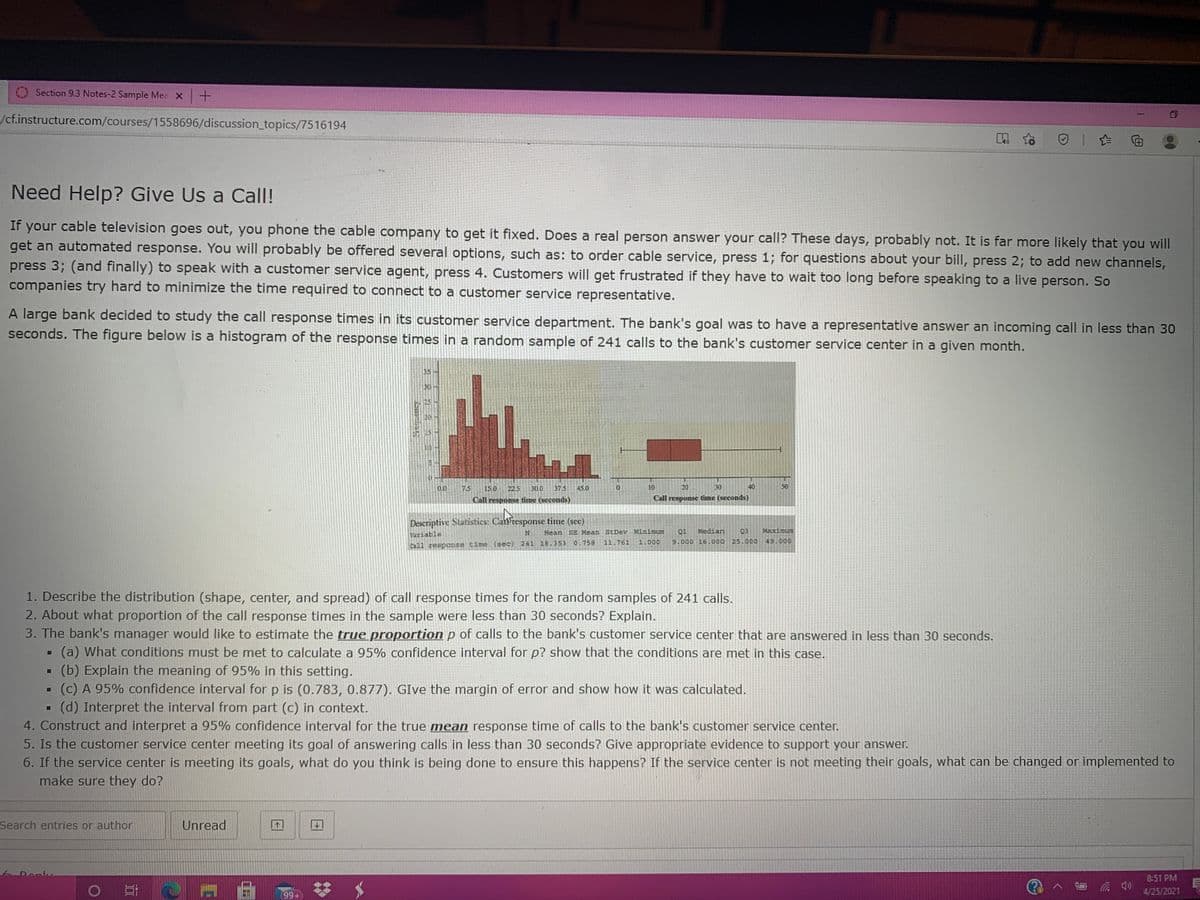If your cable television goes out, you phone the cable company to get it fixed. Does a real person answer your call? These days, probably not. It is far more likely that you will get an automated response. You will probably be offered several options, such as: to order cable service, press 1; for questions about your bill, press 2; to add new channels, press 3; (and finally) to speak with a customer service agent, press 4. Customers will get frustrated if they have to wait too long before speaking to a live person. So companies try hard to minimize the time required to connect to a customer service representative. A large bank decided to study the call response times in its customer service department. The bank's goal was to have a representative answer an incoming call in less than 30 seconds. The figure below is a histogram of the response times in a random sample of 241 calls to the bank's customer service center in a given month. Call response tme teconds) Call respoase time (econds) Descriptive Slatistics: Ca'response time (see) Turiable * Mean sE Mean sEDev Miainun Median Maximun ll reaponse tine (eec 241 1835) 0.754 11.761 1.000 9.000 16.000 25.000 49.000 1. Describe the distribution (shape, center, and spread) of call response times for the random samples of 241 calls. 2. About what proportion of the call response times in the sample were less than 30 seconds? Explain. 3. The bank's manager would like to estimate the true proportion p of calls to the bank's customer service center that are answered in less than 30 seconds. • (a) What conditions must be met to calculate a 95% confidence interval for p? show that the conditions are met in this case. . (b) Explain the meaning of 95% in this setting. • (c) A 95% confidence interval for p is (0.783, 0.877). GIve the margin of error and show how it was calculated. • (d) Interpret the interval from part (c) in context. 4. Construct and interpret a 95% confidence interval for the true mean response time of calls to the bank's customer service center. 5. Is the customer service center meeting its goal of answering calls in less than 30 seconds? Give appropriate evidence to support your answer. 6. If the service center is meeting its goals, what do you think is being done to ensure this happens? If the service center is not meeting their goals, what can be changed or implemented to make sure they do?
Addition Rule of Probability
It simply refers to the likelihood of an event taking place whenever the occurrence of an event is uncertain. The probability of a single event can be calculated by dividing the number of successful trials of that event by the total number of trials.
Expected Value
When a large number of trials are performed for any random variable ‘X’, the predicted result is most likely the mean of all the outcomes for the random variable and it is known as expected value also known as expectation. The expected value, also known as the expectation, is denoted by: E(X).
Probability Distributions
Understanding probability is necessary to know the probability distributions. In statistics, probability is how the uncertainty of an event is measured. This event can be anything. The most common examples include tossing a coin, rolling a die, or choosing a card. Each of these events has multiple possibilities. Every such possibility is measured with the help of probability. To be more precise, the probability is used for calculating the occurrence of events that may or may not happen. Probability does not give sure results. Unless the probability of any event is 1, the different outcomes may or may not happen in real life, regardless of how less or how more their probability is.
Basic Probability
The simple definition of probability it is a chance of the occurrence of an event. It is defined in numerical form and the probability value is between 0 to 1. The probability value 0 indicates that there is no chance of that event occurring and the probability value 1 indicates that the event will occur. Sum of the probability value must be 1. The probability value is never a negative number. If it happens, then recheck the calculation.

Trending now
This is a popular solution!
Step by step
Solved in 2 steps






